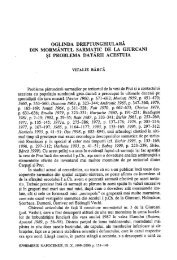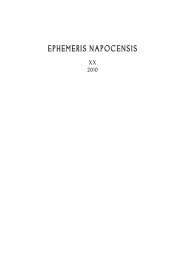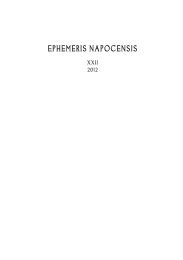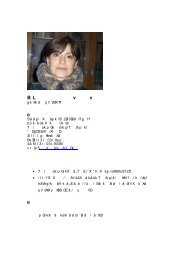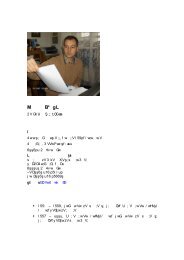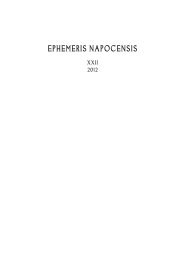ephemeris napocensis 2011 cu corectura.indd - Institutul de ...
ephemeris napocensis 2011 cu corectura.indd - Institutul de ...
ephemeris napocensis 2011 cu corectura.indd - Institutul de ...
You also want an ePaper? Increase the reach of your titles
YUMPU automatically turns print PDFs into web optimized ePapers that Google loves.
116 Monica Guiinscriptions to medicine gods are also relevant for the subject. Unlike today, going to the doctorwas probably consi<strong>de</strong>red only when everything else failed, and people didn’t have many expectationsfrom the medici 4 . As a remin<strong>de</strong>r of just how much training a professional might have had isa funerary inscription from Drobeta mentioning a medi<strong>cu</strong>s legionis who died at the age of 23 5 . Asalways (but probably more important then), prevention is the best method of preserving one’shealth, and when it comes down to the Roman army, it can be seen right from the planning ofa fort 6 . At an individual level, this is achieved through personal hygiene (which is an importantpart of being ‘Roman’ as well). Its relevanceis stressed by the omnipresent thermae, and by thenumerous toilet implements that have entered the archaeological record.2. Doctors and gods, spas and medical sanctuariesOnly one physician is known in Dacia, from a 2 nd century funerary inscription foundin Drobeta, but his troop was not part of the regular provincial army. M. Valerius Longinus,<strong>de</strong>ceased at the age of 23, was med(i<strong>cu</strong>s) leg(ionis) VII Cl(audiae) 7 and arrived in Dacia with a<strong>de</strong>tachment of that legion during the Marcommanic wars 8 .The fact that he received honorarymembership in the town council of Drobeta suggests that he employed his skills for the localcommunity as well 9 . Apparently, the reverse is also true, meaning civilian doctors could practicemedicine in military hospitals 10 .Two o<strong>cu</strong>lists are recor<strong>de</strong>d, P. Cornelius Colonus and T. Attius Divixtus 11 , but they are notnecessarily associated with the army. As a strength report of the first Tungrian cohort fromVindolandain Britannia shows, illness could hin<strong>de</strong>r the activity of a troop and eye problems seem tobe of some concern 12 . Originating in Gaul, the majority of the signa<strong>cu</strong>la o<strong>cu</strong>lariorum were foundin the western provinces of the Empire 13 . Dacia, with only a couple discovered so far, conformsto the pattern and it is notable that one of the o<strong>cu</strong>lists bears a Gallic name. The two collyriumstamps cannot be assigned with certainty to a military context. Nevertheless, the services ofthe eye specialists who used them would have been readily available to the army, since one wasfound in Apulum, and the other in Gârbou (Sălaj county), not far from the northern limes. Ithas been suggested that, since it’s very unlikely every fort had such specialists, soldiers probablybought remedies from travelling o<strong>cu</strong>lists or pharmacists 14 , and this just might be the case ofColonus or Divixtus.The suffering could go to medical sanctuaries, well known in the Roman world. InDacia, a temple of this kind was archaeologically i<strong>de</strong>ntified in Ulpia Traiana Sarmizegetusa 15 .Many inscriptions <strong>de</strong>dicated to Aes<strong>cu</strong>lapius and Hygeia were found in the city, and among the<strong>de</strong>votees, one seems to be a mil(es) leg(ionis) VI, but the piece is now lost and it could have been4ALLASON-JONES 1999, 142–143.5CIL III, 14216.9 = IDR II, 42.6Vegetius, Epitoma rei militaris, III, 2.7CIL III, 14216.9 = IDR II, 42.8BENEA 1975.9DAVIES 1969, 87.10At least this was suggested on the basis of an epigraph (AE 1998, 1134) from Moesia Inferior, found in thevaletudinarium insi<strong>de</strong> Novae legionary fortress, <strong>de</strong>dicated by a simple medi<strong>cu</strong>s, without mentioning any militaryunit (APARASCHIVEI 2010, 144).11AE 1982, 837; CIL III, 1636 = IDR III/6, 431.12Tab. Vindol. II, 154; of the 296 men in garrison, 31 were unfit for service, 15 being sick (aegri), 6 woun<strong>de</strong>d(volnerati), and 10 suffering from eye inflammation (lippientes).13KÜNZL 1984, 167; RIHA 1986, 90.14ALLASON-JONES 1999, 137.15RUSU-PESCARU/ALICU 2000, 32–42.



